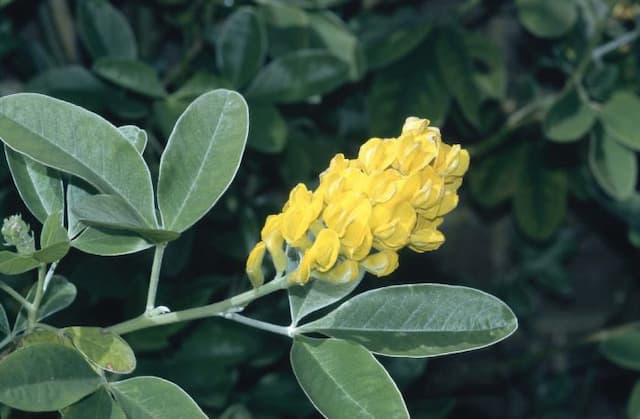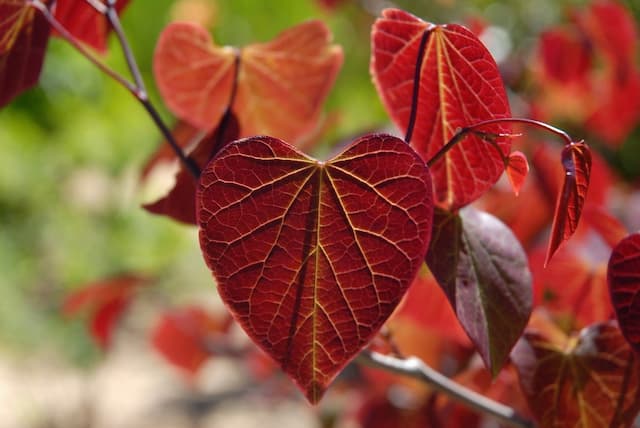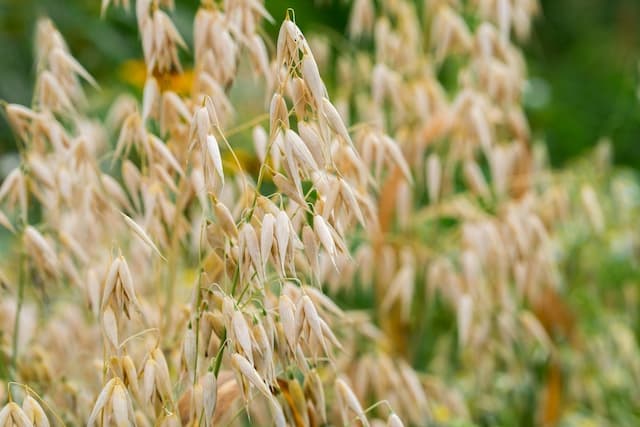Himalayan Indigo Indigofera heterantha

ABOUT
Indigofera heterantha, commonly known as Himalayan indigo, is a deciduous shrub known for its attractive foliage and blossoms. The leaves are pinnate, composed of a series of small, oval-shaped leaflets that are arranged opposite each other along a central stem. They typically exhibit a soft green hue, which can create a gentle, feathery texture in the landscape. The plant’s most distinctive feature is its flowers. During the blooming season, Himalayan indigo produces stunning spikes of densely packed flowers. These blossoms are usually a shade of vivid pink or purple, which contrasts strikingly against the greenery. The floral spikes are elongated and upright, giving the plant a visual interest that attracts pollinators and humans alike. Himalayan indigo’s branching structure is quite elegant, with multiple stems that create a rounded and bushy appearance. The bark may be visible on older growth, contributing additional texture with its somewhat rugged surface. This shrub also produces pods after the flowering period. These seed pods can provide ornamental interest even as the plant transitions into the dormant season. Overall, the appearance of Himalayan indigo is characterized by its lush foliage, attractive flowers, and graceful structure, making it a pleasing addition to garden settings where its visual attributes can be fully appreciated.
About this plant
 Names
NamesFamily
Fabaceae
Synonyms
Himalayan Indigo, Indigo Bush
Common names
Indigofera gerardiana, Indigofera dosua, Indigofera dosua var. laxa, Indigofera heterantha var. villosa, Indigofera himalayensis, Indigofera pulchella.
 Toxicity
ToxicityTo humans
Indigofera heterantha, commonly known as Himalayan indigo, is not widely recognized for its toxicity to humans. However, as with many plants, sensitive individuals may experience allergic reactions. The general rule is to avoid ingesting parts of ornamental plants due to potential risks that are not well documented. While specific symptoms of poisoning from Himalayan indigo are not well-established, ingestion of unknown plants can lead to gastrointestinal issues such as nausea, vomiting, and diarrhea. In case of ingestion and symptoms, it is important to seek medical attention.
To pets
Himalayan indigo may not be commonly reported for severe toxicity in pets, but it's always prudent to prevent pets from ingesting plants. While the specific symptoms of Himalayan indigo poisoning in pets are not extensively documented, ingestion of non-food plants can cause gastrointestinal discomfort, including vomiting and diarrhea, and in some cases, more serious health issues. If a pet ingests this plant and shows adverse symptoms, it is important to contact a veterinarian.
 Characteristics
CharacteristicsLife cycle
Perennials
Foliage type
Deciduous
Color of leaves
Green
Flower color
Pink
Height
4-6 feet (1.2-1.8 meters)
Spread
4-6 feet (1.2-1.8 meters)
Plant type
Shrub
Hardiness zones
7
Native area
Himalayas
Benefits
 General Benefits
General Benefits- Drought resistance: Indigofera heterantha, commonly known as Himalayan indigo, has a natural ability to withstand periods of low water availability, making it suitable for xeriscaping and drought-prone areas.
- Nitrogen fixation: As a member of the legume family, Himalayan indigo enriches the soil by fixing atmospheric nitrogen, which benefits surrounding plant life and improves soil fertility.
- Ornamental value: With its attractive foliage and vibrant pink to purple flowers, Himalayan indigo is commonly used in gardens and landscapes for its aesthetic appeal.
- Erosion control: The plant’s root system helps stabilize soil, making it an excellent choice for preventing soil erosion on slopes and disturbed areas.
- Wildlife habitat: Himalayan indigo provides habitat and food for various wildlife species, including serving as a host plant for certain butterfly larvae.
- Pasture improvement: It can be used in pasture mixes to improve the quality of forage for livestock due to its high protein content and palatability.
- Eco-friendly dye: The genus Indigofera is known for producing indigo dye, and while Himalayan indigo is not the primary species used commercially, it can potentially be used for natural dyeing processes.
- Low maintenance: Once established, Himalayan indigo requires minimal care, making it an easy plant to cultivate for gardeners of all levels.
 Medical Properties
Medical Properties- Antimicrobial: Indigofera heterantha is believed to exhibit antimicrobial properties, helping in the inhibition of certain bacteria and fungi.
- Anti-inflammatory: It may contain compounds that help reduce inflammation, potentially beneficial in conditions such as arthritis.
- Analgesic: The plant has been reportedly used to alleviate pain, suggesting it might contain natural pain-relieving substances.
- Antioxidant: It may contain antioxidants that help in protecting the body from oxidative stress.
- Hepatoprotective: Some studies suggest the potential use of Indigofera heterantha in protecting the liver against certain toxic substances.
 Air-purifying Qualities
Air-purifying QualitiesThis plant is not specifically known for air purifying qualities.
 Other Uses
Other Uses- Indigofera heterantha, commonly known as Himalayan indigo, can be used for soil stabilization and erosion control due to its rapid growth and ability to propagate in challenging terrains.
- The plant has potential as an ornamental species in gardens, especially rock gardens, because of its attractive foliage and pink to violet flowers.
- Its wood, being hard and durable, is sometimes used in construction or to make small tools and implements in its native regions.
- Farmers sometimes use the plant as a boundary or hedging species to demarcate land due to its dense growth habit.
- Himalayan indigo can be used in agroforestry systems as a living fence that also benefits the soil and other nearby plants.
- The plant's capability to fix nitrogen in the soil makes it valuable for crop rotation and improving soil fertility in agriculture.
- Due to its thick foliage, Himalayan indigo can provide under-plantings beneath larger trees or on edges of forested areas for undercanopy support.
- Himalayan indigo, with its colorful blossoms, can be a source of nectar for pollinators such as bees and butterflies, supporting local biodiversity.
- Its dense growth can also provide shelter and nesting sites for small birds and other fauna in garden and wild settings.
- In areas where the plant is native, the leaves can be used as fodder for livestock, particularly in times of scarcity.
Interesting Facts
 Feng Shui
Feng ShuiThe Indigofera is not used in Feng Shui practice.
 Zodiac Sign Compitability
Zodiac Sign CompitabilityThe Indigofera is not used in astrology practice.
 Plant Symbolism
Plant Symbolism- Transformation - The Indigofera heterantha, commonly known as the Himalayan indigo, is often linked with transformation due to its ability to change the color of fabrics with its dye-producing qualities, symbolizing change and metamorphosis.
- Mystery - The deep indigo color produced by the Himalayan indigo is associated with the unknown and the depths of the human psyche, embodying the mysteries of life and the spiritual realm.
- Creativity - As a source of rich dye, Himalayan indigo represents creativity and the artistic process, inspiring innovation and expression in various forms of art and cultural practices.
- Intuition - The dark blue hue of indigo is frequently connected to intuition and inner wisdom, suggesting that the Himalayan indigo symbolizes an awakening of inner knowledge and psychic abilities.
 Water
WaterHimalayan indigo should be watered regularly during its growing season, ensuring the soil is consistently moist but not waterlogged. Generally, this equates to approximately 1 inch of water per week, though this can vary depending on climate conditions and soil type. During hot, dry spells, increase watering slightly, and always check the soil moisture at a depth of an inch - it should feel slightly damp. In winter months, reduce watering as the plant requires less moisture when it's not actively growing. Make sure to water at the base of the plant to minimize leaf wetness and potential disease issues.
 Light
LightHimalayan indigo thrives in full sun to partial shade. The ideal spot for this plant is in an area that receives at least 6 hours of direct sunlight each day. Too much shade will result in fewer blooms and a leggy plant, so aim for a location that offers bright, unfiltered light for the healthiest growth.
 Temperature
TemperatureHimalayan indigo performs well in a wide range of temperatures, but its ideal growing conditions are between 50°F and 85°F. It is quite cold hardy and can survive in temperatures as low as 10°F once established. However, protect young plants from frost and extended periods of freezing temperatures which can cause damage to new growth.
 Pruning
PruningPrune Himalayan indigo to maintain its shape and encourage bushier growth. Cut back the plant in early spring before new growth starts, removing any dead or damaged branches. A light trim after the first flowering can also promote a second bloom period. Pruning once or twice a year is generally sufficient. The best time for heavy pruning is late winter to early spring.
 Cleaning
CleaningAs needed
 Soil
SoilHimalayan indigo prefers a well-draining soil mix composed of loam, sand, and organic compost with a slightly acidic to neutral pH of 5.5 to 7.0 to thrive optimally.
 Repotting
RepottingHimalayan indigo should be repotted every 2-3 years or when it outgrows its current pot to ensure continued growth and health.
 Humidity & Misting
Humidity & MistingHimalayan indigo tolerates a wide range of humidity levels and does not require any special humidity considerations, thriving well in average ambient moisture.
 Suitable locations
Suitable locationsIndoor
Place Himalayan indigo near a sunny window; ensure pot has drainage.
Outdoor
Plant Himalayan indigo in full sun; protect from strong winds.
Hardiness zone
Himalayan indigo is suitable for USDA zones 6-9.
 Life cycle
Life cycleIndigofera heterantha, commonly known as Himalayan indigo, begins its life as a seed that germinates in late winter to early spring, thriving in well-drained soils with full to partial sun. The seedling stage involves the emergence of a simple root system and cotyledons that provide initial sustenance to the plant. As it enters the vegetative stage, the Himalayan indigo develops compound leaves and a woody stem, growing into a shrub up to 2 meters tall in ideal conditions. During the reproductive stage, from late spring to summer, it produces spikes of purple-pink flowers that are attractive to a variety of pollinators and are followed by the development of seed pods. After pollination, the seeds mature within the pods, which eventually dry and split open to release the seeds for dispersal. This deciduous shrub completes its cycle by entering a period of dormancy during the winter months, where it loses its leaves and conserves energy until the next growing season begins.
 Propogation
PropogationPropogation time
Spring-Early Summer
Propogation: Indigofera heterantha, commonly known as Himalayan indigo, can typically be propagated through seed or cuttings, with the most popular method being through cuttings. The best time for propagation by cuttings is in the late spring or early summer when the plant's growth is most vigorous. To propagate Himalayan indigo by cuttings, take a cutting of about 4 to 6 inches (10 to 15 centimeters) from a healthy, mature plant. Strip the leaves from the lower half of the cutting and dip the cut end into a rooting hormone to encourage root development. Plant the cutting in a well-draining soil mix, water it thoroughly, and place it in a warm spot with indirect light. Keep the soil consistently moist but not waterlogged, and within a few weeks, the cutting should begin to root and can eventually be transplanted outdoors.









